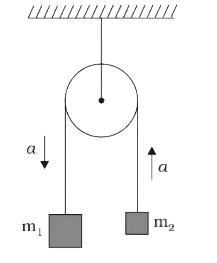Two bodies of masses m and 4 m are moving with equal K.E. The ratio of their linear momentum is
4:1
1:1
1:2
1:4
The correct Answer is:c
To solve the problem, we need to find the ratio of the linear momentum of two bodies with masses m and 4m that are moving with equal kinetic energy.
1. Understand the relationship between Kinetic Energy and Momentum:
The kinetic energy KE of an object is given by the formula:
KE=12mv2
where m is the mass and v is the velocity of the object.
The momentum P of an object is given by:
P=mv
2. Set up the equations for both bodies:
Let the kinetic energy of both bodies be KE. For the first body with mass m:
KE1=12mv21
For the second body with mass 4m:
KE2=12(4m)v22
3. Since both bodies have equal kinetic energy:
KE1=KE2
Therefore,
12mv21=12(4m)v22
4. Simplify the equation:
Cancel 12 and m (assuming m≠0):
v21=4v22
5. Relate the velocities:
Taking the square root of both sides gives:
v1=2v2
6. Find the momentum for both bodies:
The momentum of the first body is:
P1=mv1=m(2v2)=2mv2
The momentum of the second body is:
P2=(4m)v2=4mv2
7. Calculate the ratio of their momenta:
The ratio of the momenta P1 to P2 is:
P1P2=2mv24mv2=24=12
Final Answer:
The ratio of their linear momentum is 1:2.
The kinetic energy KE of an object is given by the formula:
KE=12mv2
where m is the mass and v is the velocity of the object.
P=mv
Let the kinetic energy of both bodies be KE. For the first body with mass m:
KE1=12mv21
For the second body with mass 4m:
KE2=12(4m)v22
KE1=KE2
Therefore,
12mv21=12(4m)v22
Cancel 12 and m (assuming m≠0):
v21=4v22
Taking the square root of both sides gives:
v1=2v2
The momentum of the first body is:
P1=mv1=m(2v2)=2mv2
The momentum of the second body is:
P2=(4m)v2=4mv2
The ratio of the momenta P1 to P2 is:
P1P2=2mv24mv2=24=12
The ratio of their linear momentum is 1:2.
Topper's Solved these Questions
- COMPETITION CARE UNITBOOK - ICSECHAPTER - COMPETITION CARE UNITEXERCISE - FRICTION
22 Videos
- COMPETITION CARE UNITBOOK - ICSECHAPTER - COMPETITION CARE UNITEXERCISE - MOTION IN FLUIDS
25 Videos
- COMPETITION CARE UNITBOOK - ICSECHAPTER - COMPETITION CARE UNITEXERCISE - Dynamics ( Laws of motion )
36 Videos
- CIRCULAR MOTION BOOK - ICSECHAPTER - CIRCULAR MOTION EXERCISE - MODULE 2 (FROM ROTATIONAL KINETIC ENERGY , WORK ,POWER)
24 Videos
- DIMENSIONSBOOK - ICSECHAPTER - DIMENSIONSEXERCISE - SELECTED PROBLEMS (FROM CONVERSIONS OF ONE SYSTEMS OF UNITS INTO ANOTHER)
9 Videos
Similar Questions
Two bodies of masses m1andm2(<m1) are connected to the ends of a massless cord and allowed to move as shown in figure. The pulley is both massless and frictionless. The acceleration of the centre of mass is (m1−m2)n(m1+m2)2g. Find the value of n.

View SolutionTwo bodies of masses 4 kg and 5 kg are moving with equal momentum. Then the ratio of their respective kinetic energies is
View SolutionTwo bodies of masses m1andm2 have same kinetic energy. The ratio of their momentum is
View SolutionTwo masses of 1 gm and 4 gm are moving with equal kinetic energies. The ratio of the magnitudes of their linear momenta is
View SolutionTwo masses of 1 g and 4g are moving with equal linear momenta. The ratio of their kinetic energies is :
View SolutionTwo bodies of mass 1kgand2kg have equal momentum. The ratio of their kinetic energies is:
View SolutionTwo bodies of masses m1 and m2 have equal KE. Their momenta is in the ratio
View SolutionTwo masses of 1 kg and 16 kg are moving with equal kinetic energy. The ratio of magnitude of the linear momentum is:
View SolutionTwo masses 1g and 9g are moving with equal kinetic energies. The ratio of the magnitudes of their respective linear momenta is
View SolutionTwo bodies of different masses are moving with same kinetic energy. Then, the ratio of their moment is equal to the ratio of their
View Solution
